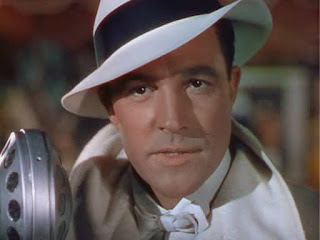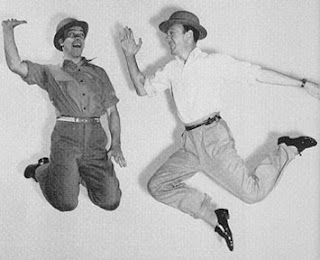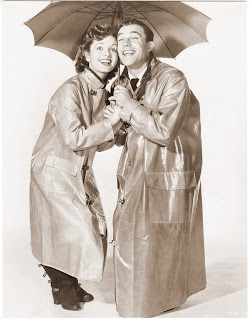 "Cold are the hands of time that creep along relentlessly, destroying slowly, but without pity, what which yesterday was young. Alone our memories resist this disintegration and grow more lovely with the passing years." -Preston Sturges
"Cold are the hands of time that creep along relentlessly, destroying slowly, but without pity, what which yesterday was young. Alone our memories resist this disintegration and grow more lovely with the passing years." -Preston Sturges Preston Sturges with Joel McCrea in a swimming pool.
Preston Sturges with Joel McCrea in a swimming pool."Sullivan's Travels" (1941) - New Friends clip: Preston Sturges' masterpiece starring Joel McCrea and Veronica Lake about a Hollywood comedy director who poses as a bum to find out about the real world. In this scene he starts his trip at a local diner at the edge of town and meets the sultry Ms. Lake and forms a lasting friendship. Writer and film critic James Agee wrote of Sullivan's Travels: "A brilliant fantasy in two keys -- slapstick farce and the tragedy of human misery."
After his experiment ends, Sully (Joel McCrea) decides that he is too happy to make "O Brother, Where Art Thou?" and would rather make people laugh.
 Veronica Lake and Joel McCrea as The Girl & John Lloyd Sullivan
Veronica Lake and Joel McCrea as The Girl & John Lloyd SullivanIn Preston Sturges' classic comedy of Depression-era America, filmmaker John L. Sullivan (Joel McCrea), fed up with directing profitable comedies like "Ants in Your Plants of 1939," is consumed with the desire to make a serious social statement in his upcoming film, "Oh Brother, Where Art Thou?" Unable to function in the rarefied atmosphere of Hollywood, Sullivan decides to hit the road, disguised as a tramp, and touch base with the "real" people of America. But Sullivan's studio transforms his odyssey into a publicity stunt, providing the would-be nomad with a luxury van, complete with butler (Robert Greig) and valet (Eric Blore). Advised by his servants that the poor resent having the rich intrude upon them, Sullivan escapes his routine and continues his travels incognito. En route, he meets a down-and-out failed actress (Veronica Lake).
 With its almost Shakespearean combination of uproarious comedy and grim tragedy, Sullivan's Travels is Sturges' masterpiece and one of the finest movies about movies ever made. Cast: William Demarest, Porter Hall, Joel McCrea, Franklin Pangborn, Robert Warwick, Veronica Lake
With its almost Shakespearean combination of uproarious comedy and grim tragedy, Sullivan's Travels is Sturges' masterpiece and one of the finest movies about movies ever made. Cast: William Demarest, Porter Hall, Joel McCrea, Franklin Pangborn, Robert Warwick, Veronica Lake Sullivan: "I'm sorry to disappoint you.... but I don't want to make O Brother, Where Art Thou? I haven't suffered enough to make O Brother, Where Art Thou?"
Sullivan: "I'm sorry to disappoint you.... but I don't want to make O Brother, Where Art Thou? I haven't suffered enough to make O Brother, Where Art Thou?"The film's last line is the clincher - the lesson he ultimately learned. He and the Girl look far off into the future as he reminisces about his experiences: "There's a lot to be said for making people laugh! Did you know that's all some people have? It isn't much but it's better than nothing in this cockeyed caravan! Boy!"
Gene Kelly (Pinky Benson) makes Shirley McLaine (Louisa May Foster) laugh in a scene from "What a way to go" (1964) directed by J. Lee Thompson
 George Cukor’s frothy showbiz exposé integrates competing versions of events that play out in flashback during the libel trial of dancer-turned-memoirist Kay Kendall. Back during their dancing days as “Barry Nichols and Les Girls,” Kendall claims her fellow trouper Taina Elg had an affair with Gene Kelly (Barry Nichols); Elg claims it was Kendall; Kelly claims they’re both wrong, he loved les troisième girl, Mitzi Gaynor, now his wife. Who’s telling the truth? Featuring Cole Porter’s final film score and Kelly’s final starring appearance in a full-blown musical. Screenplay by John Patrick, from the story by Vera Caspary. Nominated for three Oscars, winning for Orry-Kelly’s costumes.
George Cukor’s frothy showbiz exposé integrates competing versions of events that play out in flashback during the libel trial of dancer-turned-memoirist Kay Kendall. Back during their dancing days as “Barry Nichols and Les Girls,” Kendall claims her fellow trouper Taina Elg had an affair with Gene Kelly (Barry Nichols); Elg claims it was Kendall; Kelly claims they’re both wrong, he loved les troisième girl, Mitzi Gaynor, now his wife. Who’s telling the truth? Featuring Cole Porter’s final film score and Kelly’s final starring appearance in a full-blown musical. Screenplay by John Patrick, from the story by Vera Caspary. Nominated for three Oscars, winning for Orry-Kelly’s costumes. Gene Kelly in "Christmas Holiday" (1944) directed by Robert Siodmak
Gene Kelly in "Christmas Holiday" (1944) directed by Robert SiodmakWithout disparaging his towering achievements as triple threat, it is clear that Kelly's happy-go-lucky 'Yankee Doodle' dancin' boy image seems less resonant in today's pop culture vacuum. Despite superb supporting turns in "What a Way to Go!" and "Forty Carats", it is obvious that Kelly's grinning goodwill ambassador fell out of step with the sixties antiestablishment antiheroes. But Kelly's image does not need a rehabilitation so much as a reshifting "perception-wise," to paraphrase a tune from "It's Always Fair Weather".
 Mesmerized by Gene's athleticized self-approval and tireless cherchez la femme-ing, critics and audiences have overlooked the contradictions in his cocky all-American huckster persona. Debuting as a draft dodger in "For Me and My Gal", Kelly used his charisma's sinister edge to limn a mother-fixated killer in "Christmas Holiday", camouflaged his rendition of a gigolo in "An American in Paris", deftly enacted a womanizing summer schlocker in "Marjorie Morningstar", and capped off his musical comedy career as a small-time fight promoter toying with a fix in "It's Always Fair Weather".
Mesmerized by Gene's athleticized self-approval and tireless cherchez la femme-ing, critics and audiences have overlooked the contradictions in his cocky all-American huckster persona. Debuting as a draft dodger in "For Me and My Gal", Kelly used his charisma's sinister edge to limn a mother-fixated killer in "Christmas Holiday", camouflaged his rendition of a gigolo in "An American in Paris", deftly enacted a womanizing summer schlocker in "Marjorie Morningstar", and capped off his musical comedy career as a small-time fight promoter toying with a fix in "It's Always Fair Weather". Reconsidering the Kelly persona from a distance of several decades, one can enjoy his eventual triumphs over shortcomings in "Singin' in the Rain", etc. It is a tribute to his unflappable charisma that unsavory character flaws all registered as temporary slippage, indiscretions cured by true love and transformed by joyfully aggressive dance. In his most seductive choreography ("The Pirate", "Cover Girl"), he seemed to be dancing his demons away, and it is time to credit him for a more complex image than previously assumed.
Reconsidering the Kelly persona from a distance of several decades, one can enjoy his eventual triumphs over shortcomings in "Singin' in the Rain", etc. It is a tribute to his unflappable charisma that unsavory character flaws all registered as temporary slippage, indiscretions cured by true love and transformed by joyfully aggressive dance. In his most seductive choreography ("The Pirate", "Cover Girl"), he seemed to be dancing his demons away, and it is time to credit him for a more complex image than previously assumed. If his solo work reveals a pretentiousness that never darkened Astaire's sunny horizons, no male dancer was ever as sexually potent in tandem on-screen;
If his solo work reveals a pretentiousness that never darkened Astaire's sunny horizons, no male dancer was ever as sexually potent in tandem on-screen; he can make a soft shoe with Debbie Reynolds an adventure in eros. It was barbarous of MGM not to lend him for "Guys and Dolls" and "Pal Joey". Kelly could take comfort in his singular contribution to the all-but-extinct musical form; time will reveal an icon more complex than the quixotic puddle jumper of "Singin' in the Rain". In film after film, this superb actor choked back darker impulses to earn his goodness; he is the all-American operator who plays all the angles, but ultimately seeks the light in a song-and-dance spotlight. Source: www.filmreference.com
he can make a soft shoe with Debbie Reynolds an adventure in eros. It was barbarous of MGM not to lend him for "Guys and Dolls" and "Pal Joey". Kelly could take comfort in his singular contribution to the all-but-extinct musical form; time will reveal an icon more complex than the quixotic puddle jumper of "Singin' in the Rain". In film after film, this superb actor choked back darker impulses to earn his goodness; he is the all-American operator who plays all the angles, but ultimately seeks the light in a song-and-dance spotlight. Source: www.filmreference.com That infamous scene in "A Clockwork Orange" (1971) -directed by Stanley Kubrick- where Malcolm McDowell’s character warbles "Singin’ in the Rain" while terrorizing a couple didn’t sit well with the man who immortalized the song: Gene Kelly. McDowell told Bill Newcott about their awkward encounter at a Hollywood party.
That infamous scene in "A Clockwork Orange" (1971) -directed by Stanley Kubrick- where Malcolm McDowell’s character warbles "Singin’ in the Rain" while terrorizing a couple didn’t sit well with the man who immortalized the song: Gene Kelly. McDowell told Bill Newcott about their awkward encounter at a Hollywood party. -Well as you know, when "Singing In The Rain" came out, for generations of people, him swinging around that lamp post and slapping in that water, and singing… it’s one of the most euphoric moments we’ve ever seen on film. So when I had to come up with something for this sequence, which involved my character in a very brutal situation, that’s when he’s happiest. So “Singing In The Rain” just popped out. I just started singing it, and Kubrick bought the rights and we redid the whole thing and incorporated it.
-Well as you know, when "Singing In The Rain" came out, for generations of people, him swinging around that lamp post and slapping in that water, and singing… it’s one of the most euphoric moments we’ve ever seen on film. So when I had to come up with something for this sequence, which involved my character in a very brutal situation, that’s when he’s happiest. So “Singing In The Rain” just popped out. I just started singing it, and Kubrick bought the rights and we redid the whole thing and incorporated it. -I was invited to come to Hollywood by Warner Brothers. I came out and it was very nice to meet everybody. I had never been to Hollywood before. And some guy who was my minder said, “Hey, there’s a party in Beverley Hills tonight, Malcolm. Do you want to go, there’s going to be lots of stars there?” And I went, “Yeah!” I would love to!” And we go and he said, “Hey, you won’t believe this. Gene Kelly’s here. Would you like to meet him?” And I went, “Oh yeah!” So had his back to me and he tapped him on the shoulder and said, “Gene, I’d like to introduce you to Malcolm McDowell” and he looked at me… then turned around and walked off. But you know, I totally understood. I guess I kind of ruined his moment in a way. But of course, it was an homage to him, because it was so amazing. And so indelible in me as a person, that I blurted it out and started singing it.
-I was invited to come to Hollywood by Warner Brothers. I came out and it was very nice to meet everybody. I had never been to Hollywood before. And some guy who was my minder said, “Hey, there’s a party in Beverley Hills tonight, Malcolm. Do you want to go, there’s going to be lots of stars there?” And I went, “Yeah!” I would love to!” And we go and he said, “Hey, you won’t believe this. Gene Kelly’s here. Would you like to meet him?” And I went, “Oh yeah!” So had his back to me and he tapped him on the shoulder and said, “Gene, I’d like to introduce you to Malcolm McDowell” and he looked at me… then turned around and walked off. But you know, I totally understood. I guess I kind of ruined his moment in a way. But of course, it was an homage to him, because it was so amazing. And so indelible in me as a person, that I blurted it out and started singing it. Brilliant, electric, and always inventive, Gene Kelly defined the Golden Age of the movie musical, not only as the genre’s biggest star after WWII, but as an innovative dance choreographer and director (with underrated acting skills, to boot). His collaborations with choreographer/director Stanley Donen — including ON THE TOWN, SINGIN’ IN THE RAIN, and IT’S ALWAYS FAIR WEATHER — revolutionized dance on screen and the look of movie musicals.
Brilliant, electric, and always inventive, Gene Kelly defined the Golden Age of the movie musical, not only as the genre’s biggest star after WWII, but as an innovative dance choreographer and director (with underrated acting skills, to boot). His collaborations with choreographer/director Stanley Donen — including ON THE TOWN, SINGIN’ IN THE RAIN, and IT’S ALWAYS FAIR WEATHER — revolutionized dance on screen and the look of movie musicals. Kelly and Donen’s work relocated prewar films’ penchant for escapism and fantasy to the real world, reflecting real-world concerns, and better integrating the dance and musical numbers into the characters’ story, even their psychology. This modern approach has ensured the lasting appeal of their work (also on display in the choreography for LIVING IN A BIG WAY, COVER GIRL, ANCHORS AWEIGH, and TAKE ME OUT TO THE BALL GAME).
Kelly and Donen’s work relocated prewar films’ penchant for escapism and fantasy to the real world, reflecting real-world concerns, and better integrating the dance and musical numbers into the characters’ story, even their psychology. This modern approach has ensured the lasting appeal of their work (also on display in the choreography for LIVING IN A BIG WAY, COVER GIRL, ANCHORS AWEIGH, and TAKE ME OUT TO THE BALL GAME). In later years, Kelly played an ambassadorial role for the movie musical through his involvement with and appearances in the MGM anthologies THAT’S ENTERTAINMENT and THAT’S DANCING. Gene Kelly received the AFI Life Achievement Award in 1985.
In later years, Kelly played an ambassadorial role for the movie musical through his involvement with and appearances in the MGM anthologies THAT’S ENTERTAINMENT and THAT’S DANCING. Gene Kelly received the AFI Life Achievement Award in 1985. Cyd Charisse and Gene Kelly in "Brigadoon" (1954) directed by Vincente Minnelli
Cyd Charisse and Gene Kelly in "Brigadoon" (1954) directed by Vincente Minnelli “He wanted to create numbers in which the dancer did with his body what the actor did with words. He strove to devise a cinematic language of dance which replaced dialogue and told the audience what the character felt, thought, was.” —Gene Kelly biographer's Jeanine Basinger
“He wanted to create numbers in which the dancer did with his body what the actor did with words. He strove to devise a cinematic language of dance which replaced dialogue and told the audience what the character felt, thought, was.” —Gene Kelly biographer's Jeanine Basinger













No comments :
Post a Comment